John Campbell, 2nd Duke of Argyll
Field Marshal John Campbell, 2nd Duke of Argyll, 1st Duke of Greenwich, KG, KT (10 October 1680 – 4 October 1743[1]), styled Lord Lorne from 1680 to 1703, was a Scottish nobleman and senior commander in the British Army. He served on the continent in the Nine Years' War and fought at the Battle of Kaiserwerth during the War of the Spanish Succession. He went on to serve as a brigade commander during the later battles of the War of the Spanish Succession. Next he was given command of all British forces in Spain at the instigation of the Harley Ministry; after conducting a successful evacuation of the troops from Spain, he became Commander-in-Chief, Scotland. During the Jacobite Rebellion, he led the government army against the Jacobites led by the Earl of Mar at the Battle of Sheriffmuir. He went on to serve as Lord Steward and then Master-General of the Ordnance under the Walpole–Townshend Ministry.
The Duke of Argyll | |
|---|---|
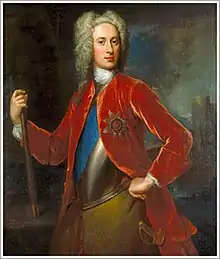 | |
| Predecessor | Archibald Campbell, 1st Duke of Argyll |
| Successor | Archibald Campbell, 3rd Duke of Argyll |
| Other names | Iain Ruaidh nan Cath or Red John of the Battles |
| Born | 10 October 1680[1] Ham House, Petersham, Surrey |
| Died | 4 October 1743 (aged 62) Sudbrook Park, Petersham |
| Buried | Westminster Abbey |
| Wars and battles | Nine Years' War War of the Spanish Succession Jacobite rebellion of 1715 |
| Spouse(s) | Mary Brown Jane Warburton |
| Issue | |
| Parents | Archibald Campbell, 1st Duke of Argyll Elizabeth Tollemache |
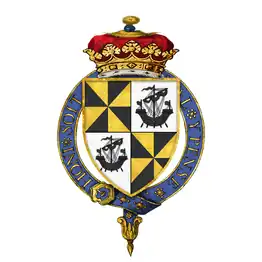
Early life
Born at Ham House, he was the son of Archibald Campbell, 1st Duke of Argyll and Elizabeth Campbell (née Tollemache, daughter of Sir Lionel Tollemache, 3rd Baronet). His mother was a stepdaughter of John Maitland, Duke of Lauderdale, a dominant figure in Scotland during Charles II's reign. Five years after his birth, Campbell's grandfather Archibald Campbell, 9th Earl of Argyll led Argyll's Rising against the rule of James II of England and VII of Scotland for which he was executed in Edinburgh in June 1685. Campbell was privately tutored first by Walter Campbell of Dunloskin, then by John Anderson of Dumbarton and, finally, by Alexander Cunningham.[2]
Early military career
He was commissioned, after his father had given William III some encouragement, as colonel of Lord Lorne's Regiment of Foot, a regiment entirely raised by the Argyll family, on 7 April 1694.[2] Campbell served briefly on the continent in the Nine Years' War before the regiment was disbanded in 1698.[3] He also served under the Duke of Marlborough at the Battle of Kaiserwerth in April 1702 during the War of the Spanish Succession.[3] He was appointed a Knight of the Order of the Thistle later that year.[2]
Campbell succeeded his father as Duke of Argyll and Chief of Clan Campbell and also became colonel of the 4th Troop of Horse Guards in 1703.[3] For the help he gave the King persuading the Parliament of Scotland to support the Act of Union, he was created Earl of Greenwich and Baron Chatham in 1705.[4] He then returned to the continent and, having been promoted to major-general early in 1706, served as a brigade commander under Marlborough at the Battle of Ramillies in May 1706 and at the Siege of Ostend in June 1706.[4] After being appointed colonel of Prince George of Denmark's Regiment in 1707, he went on to command a brigade at the Battle of Oudenarde in July 1708 and at the Siege of Lille in Autumn 1708.[4] Promoted to lieutenant general in April 1709, he also took part in the Siege of Tournai in June 1709 and the Battle of Malplaquet in September 1709.[4]
Appointed a Knight of the Order of the Garter in December 1710, Campbell was promoted to full general and given command of all British forces in Spain at the instigation of the Harley Ministry in January 1711.[4] He replaced James Stanhope who had been forced to surrender at Brihuega the previous December. The Harley government was negotiating an agreement with France which would see Britain recognise Philip V of Spain, in exchange for being allowed to retain Gibraltar and Minorca.[5]
After conducting a successful evacuation of the troops from Spain he became Commander-in-Chief, Scotland in 1712.[4] By 1713, however, Campbell had become critical of the ministry, and he joined the Whig opposition in making speeches against the government's policy on the Malt Tax.[4] In July 1714, during Queen Anne's last illness, Campbell gave his full support to the Hanoverian succession.[4] He was rewarded with the colonelcy of the Royal Horse Guards in June 1715.[4]
Jacobite uprising
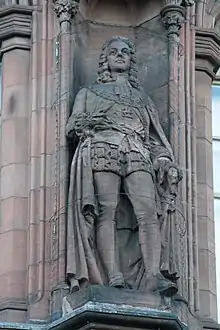
During the Jacobite Rebellion, Campbell led the government army against the Jacobites led by the Earl of Mar at the Battle of Sheriffmuir in November 1715.[4] The battle was indecisive but favoured the government strategically. He led the advance against the Jacobite capital of Perth, capturing it in December, but was then replaced as commander by William Cadogan.[6]
Later career
He was rewarded by being created Duke of Greenwich in 1719.[4] He went on to become Lord Steward in 1721 and then Master-General of the Ordnance in June 1725[7] under the Walpole–Townshend Ministry. He also became colonel of the Queen's Regiment of Horse in August 1726[8] and, having been appointed Governor of Portsmouth in November 1730,[9] he was restored to the colonelcy of the Royal Horse Guards in August 1733.[10]
In the 1720s he commissioned the architect James Gibbs to design a Palladian house at Sudbrook Park close to his birthplace at Ham House.[11]
Promoted to field marshal on 31 January 1735,[12] Campbell was stripped of his post as Master-General of the Ordnance and the colonelcy of the Royal Horse Guards for opposing the Government of Robert Walpole in 1740.[13] However he was restored to his post as Master-General of the Ordnance in February 1741[14] and restored to his colonelcy a few days later.[15]
Campbell died at Sudbrook Park, Petersham on 4 October 1743 and was buried in Westminster Abbey; his grave is marked by a small lozenge stone to the north east of Henry VII's tomb. A large monument, designed by the French sculptor, Louis-François Roubiliac, was erected for him in the south transept and unveiled in 1749.[1]
Argyll Street in London's West End is named after him.[16]
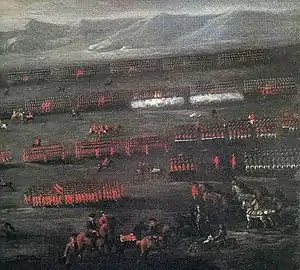
Family
Campbell married first, Mary Brown, daughter of John Brown and Ursula Duncombe, in 1701: they separated soon after the marriage and she died in 1717 and was buried in Westminster Abbey.[1] He married secondly, Jane Warburton, daughter of Thomas Warburton and Anne Williams and maid of honour to Queen Anne, in 1717: Jane died in 1767 and was buried with him in Westminster Abbey. He had four daughters who reached maturity: Caroline Townshend, 1st Baroness Greenwich, Lady Elizabeth Campbell, Lady Anne Campbell and Lady Mary Coke.[17]
In popular culture
Campbell is played by James Robertson Justice in the 1953 film Rob Roy, the Highland Rogue.[18] He is played by Andrew Keir in Michael Caton-Jones's Rob Roy.[19]
References
- "John Campbell, 2nd Duke of Argyll". Westminster Abbey. Retrieved 27 July 2014.
- "John Campbell, 2nd Duke of Argyll". Oxford Dictionary of National Biography. Retrieved 27 July 2014.
- Heathcote, p.71
- Heathcote, p. 72
- "The Treaties of Utrecht (1713)". Heraldica. Retrieved 26 September 2019.
-
 This article incorporates text from a publication now in the public domain: "Cadogan, William (1675-1726)". Dictionary of National Biography. London: Smith, Elder & Co. 1885–1900.
This article incorporates text from a publication now in the public domain: "Cadogan, William (1675-1726)". Dictionary of National Biography. London: Smith, Elder & Co. 1885–1900. - "No. 6378". The London Gazette. 1 June 1725. p. 1.
- "No. 6506". The London Gazette. 23 August 1726. p. 1.
- "No. 6932". The London Gazette. 3 November 1730. p. 1.
- "No. 7219". The London Gazette. 4 August 1733. p. 3.
- "The Clubhouse". The Richmond Golf Club. Retrieved 5 December 2012.
- "No. 7476". The London Gazette. 27 January 1735. p. 1.
- Heathcote, p. 73
- "No. 8094". The London Gazette. 16 February 1741. p. 2.
- "No. 8096". The London Gazette. 23 February 1741. p. 7.
- Weinreb, Ben, and Hibbert, Christopher (1992). The London Encyclopaedia (reprint ed.). Macmillan. p. 25.CS1 maint: uses authors parameter (link)
- Mosley, p. 607
- Rob Roy, the Highland Rogue at IMDb
- Rob Roy at IMDb
Sources
- Hugill, J.A.C. No Peace Without Spain. Kensal Press, 1991.
- Heathcote, Tony (1999). The British Field Marshals 1736-1997. Pen & Sword Books Ltd. ISBN 0-85052-696-5.
- Mosley, Charles (2003). Burke's Peerage, Baronetage & Knightage, 107th edition, Volume I. Burke's Peerage (Genealogical Books). ISBN 978-0971196629.
External links
| Parliament of Scotland | ||
|---|---|---|
| Preceded by The Marquess of Tweeddale |
Lord High Commissioner 1705–1706 |
Succeeded by The Duke of Queensberry |
| Political offices | ||
| Preceded by The Duke of Kent |
Lord Steward 1718–1725 |
Succeeded by The Duke of Dorset |
| Military offices | ||
| Preceded by Earl of Argyll |
Colonel of Lord Lorne's Regiment of Foot 1694–1697 |
Regiment disbanded |
| Colonel of the 4th Troop of Horse Guards 1703–1715 |
Succeeded by The Earl of Dundonald | |
| Preceded by Lord Strathnaver |
Colonel of The Duke of Argyll's Regiment of Foot 1703–1707 |
Succeeded by Marquess of Tullibardine |
| Preceded by Thomas Stringer |
Colonel of The Duke of Argyll's Regiment of Foot 1706–1707 |
Succeeded by The Earl of Orrery |
| Preceded by Charles Churchill |
Colonel of Prince George of Denmark's Regiment 1707–1711 |
Succeeded by John Selwyn |
| Preceded by The Earl of Leven |
Governor of Edinburgh Castle 1712–1714 |
Succeeded by The Earl of Orkney |
| Preceded by The Earl of Peterborough |
Colonel of the Royal Horse Guards 1715–1717 |
Succeeded by The Duke of Bolton |
| Preceded by The Lord Londonderry |
Colonel of The Queen's Regiment of Horse 1726–1733 |
Succeeded by William Evans |
| Preceded by The Duke of Bolton |
Colonel of the Royal Horse Guards 1733–1740 |
Succeeded by Lord Seymour |
| Preceded by Earl of Hertford |
Colonel of the Royal Horse Guards 1741–1742 |
Succeeded by Earl of Hertford |
| Preceded by The Earl of Leven |
Commander-in-Chief, Scotland 1712–1716 |
Succeeded by The Lord Carpenter |
| Preceded by The Earl Cadogan |
Master-General of the Ordnance 1725–1740 |
Succeeded by The Duke of Montagu |
| Preceded by George MacCartney |
Governor of Portsmouth 1730–1737 |
Succeeded by The Viscount Shannon |
| Preceded by The Duke of Montagu |
Master-General of the Ordnance 1741–1742 |
Succeeded by The Duke of Montagu |
| Honorary titles | ||
| Preceded by The Earl of Halifax |
Lord Lieutenant of Surrey 1715–1716 |
Succeeded by The Lord Onslow |
| Peerage of Scotland | ||
| Preceded by Archibald Campbell |
Duke of Argyll 1703–1743 |
Succeeded by Archibald Campbell |
| Peerage of Great Britain | ||
| New creation | Duke of Greenwich 1719–1743 |
Extinct |
| Peerage of England | ||
| New creation | Earl of Greenwich 1705–1743 |
Extinct |
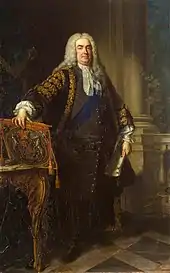
.jpg.webp)